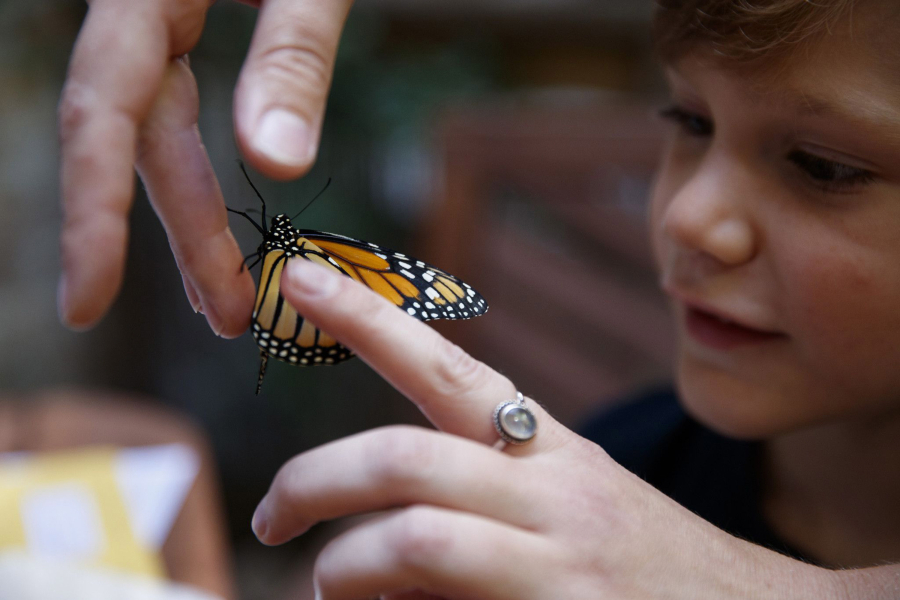CHICAGO – Breanna Seibel was riding a four-wheeler alongside her alfalfa field in northern Wisconsin when she started seeing monarch butterflies. The bright orange visitors were swooping, fluttering and dancing in pairs, quartets and trios. They were landing in the trees that line the field, with up to 100 clustered on a single branch.
Seibel called her parents out to see the butterflies: thousands, by her count.
She posted videos on Facebook, and strangers started showing up at her doorstep, asking for a tour.
“It’s like nothing you’ve ever seen before,” said Seibel, 28, of New Richmond, Wisc. “It’s like a Disney movie, except better.”
The fall monarch migration, in which millions of butterflies travel up to 3,000 miles south to California and Mexico, is already underway in Wisconsin and Canada, with reports of the intrepid insects gathering in large groups to rest in trees or refuel in nectar-rich fields. And the spectacle will likely reach Chicago next week, according to Peggy Notebaert Nature Museum chief curator Doug Taron.
Expect more monarchs in gardens, parks, forests and fields. And if you’re exploring green areas along Lake Michigan, keep an eye out for “roosts” where dozens — or even hundreds — of monarchs spend the night in a single tree.
Those who prefer monarchs-on-demand can attend butterfly festivals such as Flutter Into Fall on Sept. 12 at the Peggy Notebaert Nature Museum, which will include a chance to see monarch tagging, in which tiny stickers are attached to the insects’ wings before release.
Local monarch fests include the Forest Preserves of Cook County’s Migrating Monarchs Celebration in River Forest on Sept. 12, and Oak Lawn Park District’s Monarch Festival on Sept. 18.
The monarch population has been in decline for the past 20 years, spurring conservation efforts by both scientists and everyday people, who grow milkweed in gardens, fields and parkways. The butterflies, while not yet officially recognized as an endangered or threatened species, meet the criteria for inclusion, according to the U.S. Fish and Wildlife Service.
But millions of monarchs still make the annual trip south across the U.S. and Canada to California and Mexico, with thousands flying from Illinois to Michoacán, Mexico, a journey of abut 2,000 miles.
Scientists know the butterflies navigate south using their internal circadian clocks and the sun’s position in the sky, Taron said, but that doesn’t explain how the tiny travelers wind up year after year in the same small reserves northwest of Mexico City.
“This is really one of the big mysteries of the world,” he said. “The most recent butterflies that have been in the areas where they’re going are their great-great-great-grandparents.”
The monarchs winter on trees high up in the mountains of the Transvolcanic Belt mountain range. Temperatures often dip below freezing at night, and it’s not unusual to see snow on the butterflies, Taron said. The same butterflies start flying north again in spring, reaching the Rio Grande Valley in Texas before laying eggs and dying.
Subsequent generations fly north, making their way through the United States, and into Canada, before the next generation of long-distance flyers emerge in late summer and early fall.
The peak of monarch migration in the Chicago area typically occurs around the second week of September, Taron said.
Among those who are getting an early taste of the migration are the growing number of monarch fans who are raising the butterflies from wild eggs in their homes. Scientists discourage raising large numbers of monarchs in your home — a practice promoted on some social media pages. But experts say that raising a small number of the butterflies can be rewarding and educational.
Samantha Goodman, a former science teacher living in Chicago’s Ukrainian Village, raises small numbers of monarchs under carefully controlled conditions. Earlier this week, she was preparing to release 10 monarchs that were still in their chrysalises. The date of their expected emergence makes it likely that they will join the migration to Mexico, she said.
She planned to tag her butterflies with little lightweight stickers that are sometimes recovered at the end of the migration route, providing evidence that a specific monarch has reached Mexico.



